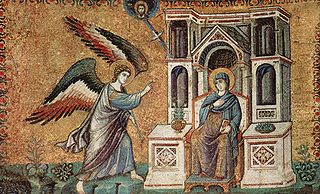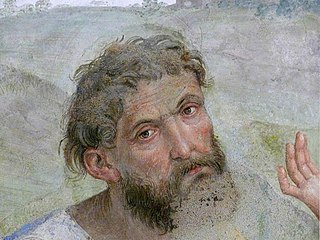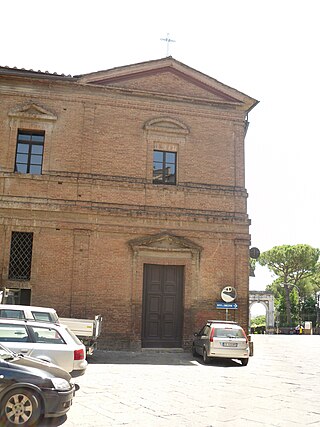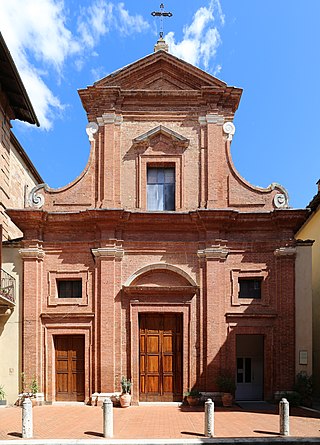
Arezzo is a city and comune in Italy and the capital of the province of the same name located in Tuscany. Arezzo is about 80 kilometres southeast of Florence at an elevation of 296 metres (971 ft) above sea level. As of 2022, the population was about 97,000.

Pietro Cavallini was an Italian painter and mosaic designer working during the late Middle Ages.

Lo Spagna, "the Spaniard" in Italian, was a painter of the High Renaissance, active in central Italy. His name was Giovanni di Pietro, but he was known as Lo Spagna because he was born in Spain. After Raphael, he was a main pupil and follower of the Umbrian painter Perugino, whose style his paintings develop. He should not be confused with Pietro di Giovanni D'Ambrogio of Siena.

The Basilica of Saint Francis of Assisi is the mother church of the Roman Catholic Order of Friars Minor Conventual in Assisi, a town in the Umbria region in central Italy, where Saint Francis was born and died. It is a papal minor basilica and one of the most important places of Christian pilgrimage in Italy. With its accompanying friary, Sacro Convento, the basilica is a distinctive landmark to those approaching Assisi. It has been a UNESCO World Heritage Site since 2000.

Poggibonsi is a town in the province of Siena, Tuscany, central Italy. It is located on the River Elsa and is the main centre of the Valdelsa Valley.

The Basilica of Saint Mary of the Angels is a papal minor basilica situated in the plain at the foot of the hill of Assisi, Italy, in the frazione of Santa Maria degli Angeli.

Santa Donna Regina Vecchia is a church in Naples, in southern Italy. It is called Vecchia ("old") to distinguish it from the newer and adjacent church of Santa Maria Donna Regina Nuova.

The Basilica of San Domenico, also known as Basilica Cateriniana, is a basilica church in Siena, Tuscany, Italy, one of the most important in the city. The basilica is an example of Cistercian Gothic style.

The Basilica dell'Osservanza is a church on the outskirts of Siena, region of Tuscany, Italy.

The Church of Santa Maria dei Servi is a Romanesque style, Roman Catholic church in the Terzo of San Martino in the city of Siena, Tuscany, Italy.

The Church of the Santuccio or Chiesa del Santuccio, is a small, Renaissance-style, Roman Catholic church located on Via Roma 69 in Siena, Italy. The church was once was part of the adjacent monastery of Santa Maria degli Angeli, occupied since 1362 by Augustinian nuns. The frescoed church is not part of the Polo Museale della Toscana, an association of museums of the Tuscan region.

San Pellegrino alla Sapienza o della Sapienza is a Gothic style, Roman Catholic church located at the intersection of via della Sapienza and via delle Terme in Siena, region of Tuscany, Italy. It is located across from the Teatro dei Rozzi.

San Giorgio is a Roman Catholic church located on the Piazza of the same name, just outside Porta Bruciata, in Brescia, region of Lombardy, Italy.
Meo di Pero, also called Meo di Piero was an Italian painter active in Siena in a Gothic style. He worked in the studio of Cristoforo di Bindoccio. All the latter paintings are generally co-attributed to Meo, since no independent work is known.

Santi Pietro e Paolo is a Baroque-style, Roman Catholic parish church located in the center of the town of Buonconvento, region of Tuscany, Italy.

San Giacinto is a Renaissance-style, former-Roman Catholic church, now deconsecrated, located at via dei Pispini 162a, in the city of Siena, region of Tuscany, Italy. It is located about 8 doors down from Porta dei Pìspini on the south side of the street.

The Villa Santa Colomba is a renaissance-style fortress palace structure located in the village of Santa Colomba, a frazione of Monteriggioni, a few miles outside Siena, in the region of Tuscany, Italy.

The Certosa di Pontignano, also known as the Certosa di San Pietro, is a Carthusian monastery and church in the neighborhood of Pontignano, within the town limits of Castelnuovo Berardenga, a few kilometers north of the city of Siena, in the region of Tuscany, Italy. The monastic complex, after the expulsion of the monks in 1810, passed through various hands, until it was acquired in 1959 by the University of Siena, and used for academic meetings, conventions, and also hotel and restaurant for events such as weddings and celebrations.

The Monastery of San Girolamo in Campansi is a former convent located on Via Campansi #18 in the city of Siena, region of Tuscany, Italy. The Baroque-style church still stands as an independent chapel; while the monastery has been converted to a nursing home for the elderly. There is a separate Monastery of San Girolamo on via San Girolamo, located in a different contrada of Siena.

Santa Marta is a former Roman Catholic convent and church of located in the city of Siena, region of Tuscany, Italy. It now serves in part as historic archive for Siena. It is located about 30 meters downhill of the Cappella del Rosario on Via San Marco and 30 meters uphill of Porta San Marco.



















